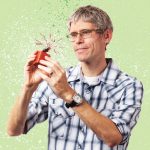In order for cancer to grow and spread, it has to evade detection by our immune cells, particularly specialized “killer” T cells. Professor Susan Kaech, Postdoctoral Fellow and first author Shihao Xu and colleagues have found that the environment inside tumors (the tumor microenvironment) contains an abundance of oxidized fat molecules, which, when ingested by the killer T cells, suppresses their ability to kill cancer cells. The discovery suggests new pathways for safeguarding the immune system’s ability to fight cancer by reducing the oxidative lipid damage in killer T cells, such as blocking a cellular fat transporter called CD36.
Read news releaseDiscoveries
Research advances one step closer to stem cell therapy for type 1 diabetes
Type 1 diabetes, which arises when the pancreas doesn’t create enough insulin to control levels of glucose in the blood, is a disease that currently has no cure and is difficult for most patients to manage. Now, research led by Juan Carlos Izpisua Belmonte, and including co-first authors Postdoctoral Fellow Ronghui Li, Staff Researcher Hsin-Kai Liao and former Research Associate Haisong Liu, has led to a new way to create insulin-producing pancreatic beta cells from stem cells that is much more efficient than previous methods. When tested in a mouse model, these beta cells brought blood sugar levels under control within about two weeks and could someday lead to better treatments for people with type 1 diabetes.
Read news releaseParkinson’s, cancer, type 2 diabetes share a key element that drives disease
When cells are stressed, chemical alarms go off, setting in motion a flurry of activity that protects the cell’s most important players. During the rush, a protein called Parkin hurries to protect the mitochondria, the power stations that generate energy for the cell. Now, Salk Professor Reuben Shaw and colleagues have discovered a direct link between a master sensor of cell stress and Parkin itself. The same pathway is also tied to type 2 diabetes and cancer, which could open a new avenue for treating all three diseases.
Release news releaseIn a surprising twist, some Alzheimer’s plaques may be protective, not destructive
One of the characteristic hallmarks of Alzheimer’s disease (AD) is the buildup of amyloid-beta plaques in the brain. Most therapies designed to treat AD target these plaques, but they’ve largely failed in clinical trials. New research by Professor Greg Lemke and Youtong Huang, a postdoctoral researcher and first author of the study, upends conventional views of the origin of one prevalent type of plaque, indicating a reason why treatments have been unsuccessful. The research suggests that dense-core plaques play a protective role, so treatments to destroy them may do more harm than good.
Read news releaseTransforming atmospheric carbon into industrially useful materials
Plants are unparalleled in their ability to capture CO2 from the air, but this benefit is temporary, as leftover crops release carbon back into the atmosphere. A more permanent, and even useful, fate for this captured carbon could be turning plants into a valuable industrial material called silicon carbide (SiC). Professor Joseph Noel, Visiting Scientist James La Clair, and Staff Researcher and first author Suzanne Thomas transformed tobacco and corn husks into SiC and quantified the process with more detail than ever before. The findings are crucial to helping researchers evaluate and quantify carbon-sequestration strategies to potentially mitigate climate change as CO2 levels continue to rise to unprecedented levels.
Read news releaseChimeric tool advanced for wide range of regenerative medicine, biomedical research applications
The ability to grow the cells of one species within an organism of a different species offers scientists a powerful tool for research and medicine. It’s an approach that could advance our understanding of early human development, disease onset and progression and aging; provide innovative platforms for drug evaluation; and address the critical need for transplantable organs. Yet developing such capabilities has been a formidable challenge. Researchers led by Professor Juan Carlos Izpisua Belmonte have now come one step closer toward this goal by demonstrating a new integration of human cells into animal tissue.
Salk scientists reveal how brain cells in Alzheimer’s go awry, lose their identity
Despite the prevalence of Alzheimer’s, there are still no treatments, in part because it has been challenging to study how the disease develops. Now, Salk President and Professor Rusty Gage and Jerome Mertens, assistant adjunct professor and first author of a new paper, have uncovered new insights into what goes awry during Alzheimer’s by growing neurons that resemble—more accurately than ever before—brain cells in older patients. And like patients themselves, the afflicted neurons appear to lose their cellular identity. The findings showed that these brain cells are characterized by markers of stress as well as changes in which the cells become less specialized. Interestingly, many of the alterations seen in these cells are similar to what’s been observed in the cells of cancer—another disease linked to aging.
Read news releaseResearchers trace spinal neuron family tree
Spinal cord nerve cells branching through the body resemble trees with limbs fanning out in every direction. But this image can also be used to tell the story of how these neurons–their jobs becoming more specialized over time–arose through developmental and evolutionary history. Professor Samuel Pfaff and graduate student Peter Osseward, co-first author of the study, have, for the first time, traced the development of spinal cord neurons using genetic signatures and revealed how different subtypes of the cells may have evolved and ultimately function to regulate our body movements. The findings offer researchers new ways of classifying and tagging subsets of spinal cord cells for further study, using genetic markers that differentiate branches of the cells’ family tree.
Read news releaseNew study shows how to boost muscle regeneration and rebuild tissue
One of the many effects of aging is loss of muscle mass, which contributes to disability in older people. To counter this loss, the lab of Professor Juan Carlos Izpisua Belmonte is studying ways to accelerate the regeneration of muscle with a combination of molecular compounds common in stem-cell research. Izpisua Belmonte and Postdoctoral Fellow and study first author Chao Wang showed that using these compounds increased the regeneration of muscle cells in mice by activating muscle-cell precursors called myogenic progenitors. The research provides insights that could one day help athletes as well as aging adults regenerate tissue more effectively.
Read news releaseInhibitory neurons target the weakest-responding neurons in the brain to facilitate transmission of signals
A new study by Professor Tatyana Sharpee and first author and postdoctoral researcher Wei-Mien Hsu shows that inhibitory neurons do more than just inhibit neuron activity like an off-switch; they actually increase the amount of information transmitted through the nervous system when it needs to be flexible. The work could help scientists better understand and treat conditions such as anxiety and attention deficit disorders.
Read news releaseSalk scientists reveal role of genetic switch in pigmentation and melanoma
Despite only accounting for about 1 percent of skin cancers, melanoma causes the majority of skin cancer-related deaths. While treatments for this serious disease do exist, these drugs can vary in effectiveness depending on the individual. A study by Professor Marc Montminy and Staff Scientist Jelena Ostojić reveals new insights about a protein called CRTC3, a genetic switch that could potentially be targeted to develop new treatments for melanoma by keeping the switch turned off.
Read news releaseHow plants quickly adapt to shifting environmental conditions
Professors and Howard Hughes Medical Institute (HHMI) Investigators Joanne Chory and Joseph Ecker, along with HHMI/Chory lab Research Specialist Björn Willige and colleagues, offer a new understanding of how gene activity directs plant growth, and how quickly plants respond to their environment—with shifting light conditions triggering molecular changes in as little as five minutes. The findings may help farmers increase yield and safeguard world food production as climate change shrinks the planet’s arable land.
Read news releaseFeatured Stories
 Building a More Resilient WorldThe world is facing an array of health-related crises: COVID-19 and other infectious diseases, climate change, neurodegenerative conditions, cancers and many more. To tackle these daunting challenges, the Institute is embarking on a philanthropic campaign to focus on resilience: the biological adaptability that mitigates the effects of aging, resists disease and restores global wellness.
Building a More Resilient WorldThe world is facing an array of health-related crises: COVID-19 and other infectious diseases, climate change, neurodegenerative conditions, cancers and many more. To tackle these daunting challenges, the Institute is embarking on a philanthropic campaign to focus on resilience: the biological adaptability that mitigates the effects of aging, resists disease and restores global wellness. Susan Kaech – How T cells rememberSalk Professor Susan Kaech, director of the NOMIS Center for Immunobiology and Microbial Pathogenesis, has made it her mission to gain a better understanding of how T cells form, how they exchange molecular signals with the surrounding tissue, and how we can use this knowledge to prevent or treat infections.
Susan Kaech – How T cells rememberSalk Professor Susan Kaech, director of the NOMIS Center for Immunobiology and Microbial Pathogenesis, has made it her mission to gain a better understanding of how T cells form, how they exchange molecular signals with the surrounding tissue, and how we can use this knowledge to prevent or treat infections.
 Carl Procko – Lessons from carnivorous plantsStaff Scientist Carl Procko studies Venus flytraps and their close relatives, Sundew plants, to gain insight into the ultra-fast biochemistry of plants and how they can sense touch. It doesn’t hurt that these bug-eating plants are a great way to get kids—and adults—interested in science.
Carl Procko – Lessons from carnivorous plantsStaff Scientist Carl Procko studies Venus flytraps and their close relatives, Sundew plants, to gain insight into the ultra-fast biochemistry of plants and how they can sense touch. It doesn’t hurt that these bug-eating plants are a great way to get kids—and adults—interested in science. Nuttida Rungratsameetaweemana – Drawing from memoriesNuttida Rungratsameetaweemana, a Salk postdoctoral researcher who studies neuroscience, was introduced to the perplexities of the brain at age 14 during a chance encounter in a hospital waiting room.
Nuttida Rungratsameetaweemana – Drawing from memoriesNuttida Rungratsameetaweemana, a Salk postdoctoral researcher who studies neuroscience, was introduced to the perplexities of the brain at age 14 during a chance encounter in a hospital waiting room.
















































